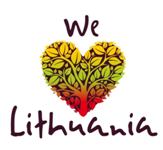…Once upon a time Grand Duke Gediminas of Lithuania, who lived in his native Kernavė at the time, set out to hunt in the woods on the other side of the River Neris. He saw a beautiful hill in the plains surrounded by oak trees. The duke was mesmerized by the magnificent place and decided to build a castle there. This is how a castle came to be built at the beginning of the 14th century and a new town, which we now call Senieji Trakai, quickly began to form around it. Gediminas made it Lithuania’s capital, even though this lasted for just a short time.
It is worth knowing that Trakai derives its name from the word ‘trakas’ (track), meaning a raised place in the forest’. The old forest and woods have disappeared, but the memory of the old landscape has remained engrossed in the name of the area.
Today’s archaeologists tell us that these surrounding areas were inhabited a very long time ago. There is some proof that close to a small lake (now marsh) a large settlement was functioning in the first millennia BC. In an effort to preserve the area, Senieji Trakai was given the status of an archaeological preserve. Excavations unearthed some interesting artifacts from various periods: animal remains, knives, keys, tips of crossbow arrows, and others. Archaeologists even found small scissors. It is speculated that these were the ones used by Birutė, the legendary wife of Duke Kęstutis, mother of Grand Duke Vytautas!
During the wars with the Teutonic Order, the number of castles in the Grand Duchy of Lithuania increased. One of Lithuania’s oldest masonry castles, Senieji Trakai Castle, was very conveniently situated in a strategic area. A castle built on a small hill fort was surrounded by a trench full of water. Written sources of the 16th century reveal a curious detail that the castle was accessible only by boat. Even much later (19th century) maps of the castle sites showed the existence of a drawbridge.
Senieji Trakai Castle is the birthplace of Grand Duke Vytautas. According to the chronicles, the year 1350 marked the birth of one of the most prominent future Lithuanian historical personalities who was born into the family of Duke Kęstutis and Priestess Birutė. At the time when the highly esteemed Duke Vytautas was the ruler, Lithuania expanded from the Baltic sea to the Black sea!
When Vytautas relocated to the new castle in Naujieji Trakai, Benedictine monks were given responsibility for his native Senieji Trakai Castle. That is how one of the first monasteries in Lithuania was founded!
Castle Site of Senieji Trakai
The castle site of Senieji Trakai is situated on a small hill and holds the status of a state-protected cultural monument. This castle as well as the Peninsula Castle were first mentioned in written sources in the 14th century and are considered enclosure-type castles. It was surrounded by a trench up to 35-40 m wide and up to 8 m deep and protected by a 10-high defensive wall.
Beginning in 1316 Senieji Trakai served as the capital of the Grand Duchy of Lithuania for seven years. After the prophetic dream of Duke Gediminas about an iron wolf and when Vilnius became the new capital, this place served as the capital of Trakai duchy and the Samogitian elder. Lithuanian sub-monarchs made the castle their residence and took on the responsibility of protecting and defending Lithuania’s western borders.
When the country was fighting with the Teutonic Order, Senieji Trakai Castle suffered numerous attacks and attempts to destroy it. A fatal battle occurred with the order in 1391 when the castle was almost completely destroyed and has never been rebuilt since. From then on, the defensive role of Senieji Trakai was diminished.
Invited to his native castle by Grand Duke Vytautas around 1410, monks from Tyneco (near Krakow) founded a monastery here. The duke built them a wooden church and allocated them a destination (ed. Old Russian measurement) of land along with two lakes. The monastery operated until the mid-19th century when it was closed by the administration of the Russian empire.
Today the top of the old castle site is occupied by a monastery and neo-gothic style church ensemble rebuilt at the turn of the 18th and 19th centuries. Linden trees that are more than 100 years old adorn the slopes of the hill fort. Senieji Trakai street village is nestled around the old castle site and has the status of an architectural sanctuary.










